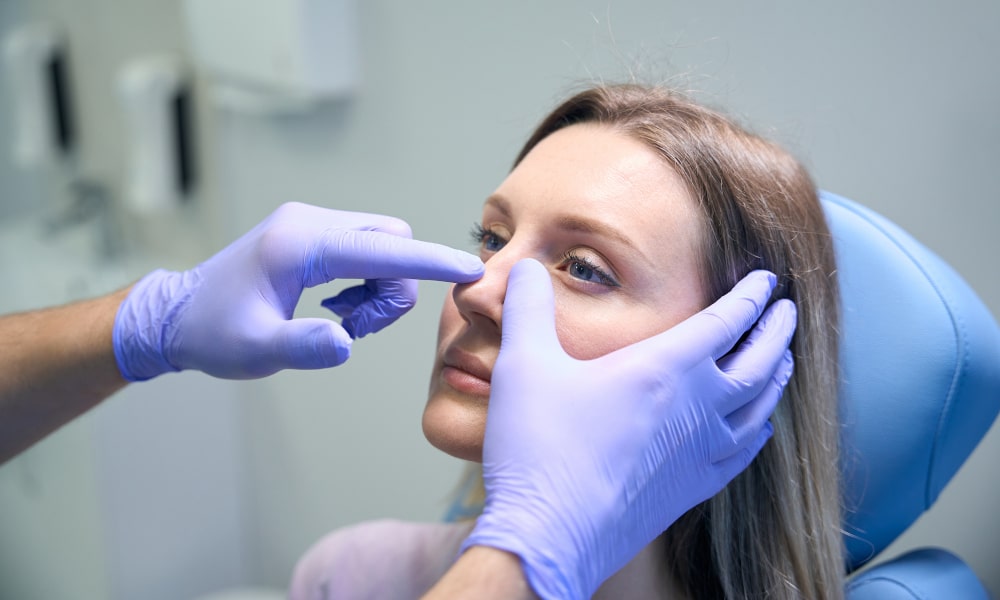
Key Takeaways
- Skin thickness has a significant impact on rhinoplasty outcomes, affecting surgical technique, healing, scarring, and the final appearance.
- Thick skin may conceal fine nasal details, while thin skin can make even minor imperfections visible.
- Pre-operative assessment of skin thickness includes manual inspection, digital imaging, and discussion of patient expectations.
- Patients with thick nasal skin can still achieve refined results with structural grafting and specialized techniques, but realistic expectations are key.
- Expert input from Dr. Richard Rival emphasizes the importance of individualized surgical planning tailored to each patient’s unique skin characteristics.
What Role Does Skin Thickness Play in the Outcome of Rhinoplasty?
Skin thickness is one of the most critical — and sometimes underestimated — factors in determining the success of rhinoplasty procedures. Individuals with thick and thin skin types present distinct challenges and advantages that necessitate different surgical approaches to achieve optimal results.
Defining Thick vs. Thin Skin in Rhinoplasty
Thick skin refers to dermal layers that are more substantial, oil-rich, and resilient. It tends to mask delicate skeletal refinements but heals with less scarring and is more forgiving of minor contour irregularities.
Thin skin, by contrast, lies closely over the nasal structure. This can make even minute imperfections noticeable, but it allows crisp definition and contouring of the nasal framework.
Dr. Richard Rival, a renowned facial plastic surgeon, explains:
“Patients with thick skin may not see extremely sharp tip definition post-surgery, but with proper structural work, beautiful balance and harmony can still be achieved.”
How Skin Thickness Affects Surgical Technique
- Thick-Skinned Patients:
- Require stronger structural support (such as cartilage grafting).
- Risk of subtle contours being hidden beneath skin layers.
- Extra attention to tip projection and shaping to overcome masking effects.
- Thin-Skinned Patients:
- There is a greater need for a smooth, symmetrical framework, as irregularities will show.
- More prone to visible scarring or sharp transitions.
- Surgeons may use soft tissue camouflage grafts to soften sharp edges.
Healing, Scarring, and Visibility of Underlying Structures
- Healing Time: Thicker skin may prolong the resolution of swelling, but thinner skin shows results earlier.
- Scarring: Less problematic in thick skin, potentially more visible in thin skin.
- Framework Visibility: Thin skin enhances the display of bone and cartilage shape; thick skin muffles this detail.
Supporting Research
In the study “Effects of Skin Thickness on Rhinoplasty Outcomes”, researchers emphasized that skin quality must direct the choice of surgical methods, reinforcing the need for careful pre-operative planning.
How Do Surgeons Assess Skin Thickness Before Rhinoplasty?
Proper evaluation of skin thickness before surgery is crucial for both setting realistic expectations and planning the surgical technique.
Pre-Operative Evaluations
- Manual Inspection: Surgeons pinch and roll the nasal skin to estimate thickness.
- Digital Imaging: Advanced imaging provides a layered view, highlighting skin thickness and distribution.
- Medical History: Conditions such as acne or rosacea may indicate skin that is thicker or more reactive.
Adjusting Technique to Skin Characteristics
- Thicker Skin:
- Use of strong structural grafting (e.g., septal or rib cartilage).
- Techniques to promote thinning or debulking of fatty skin layers if needed.
- Thinner Skin:
- Emphasis on the precision shaping of cartilage and bone.
- Possible soft tissue grafting to reduce sharp transitions.
Dr. Richard Rival advises:
“Patients must understand that skin type sets the foundation for what’s achievable. Managing expectations is part of delivering long-term satisfaction.”

Can Patients with Thick Nose Skin Still Achieve a Refined Look?
Absolutely — but it requires strategy, technique, and patience.
Realistic Expectations
Patients with thick nasal skin should be counselled on:
- Possibility of softer contour definitions.
- Longer swelling and healing periods.
- Focus on overall nasal harmony, not sharp angles.
Surgical Approaches for Structure-Building
- Cartilage Grafting: Provides necessary tip projection and support.
- Tip-Support Techniques: Such as columellar struts or shield grafts to prevent drooping.
- Thinning of Subcutaneous Tissue: Carefully performed to reduce skin bulk without damaging skin integrity.
Skin Support Methods
- Post-operative taping and splinting to maintain shape.
- Use of corticosteroid injections (in some cases) to reduce fibrous tissue buildup.
Comparison Table: Thick vs. Thin Skin in Rhinoplasty
| Feature | Thick Skin | Thin Skin |
|---|---|---|
| Definition Visibility | Less defined, softer transitions | Highly defined, crisp contours |
| Healing Time | Longer swelling resolution | Quicker visible results |
| Scarring Risk | Low | Higher risk of visible scars |
| Framework Sensitivity | Minor irregularities hidden | Imperfections easily seen |
| Surgical Emphasis | Structural support and projection | Smoothing and precision shaping |
What Are the Limitations of Rhinoplasty for Thick-Skinned Patients?
Thick skin, while offering some surgical forgiveness, introduces unique limitations that both surgeons and patients must acknowledge.
Potential Drawbacks
- Slower definition and tip refinement: The bulk of thick skin can obscure fine tip details, making a sharply defined nasal tip challenging.
- Extended swelling duration: Due to the dermal volume, edema tends to resolve slowly, thereby prolonging the period before final results are evident.
- Less pronounced angular changes: Subtle surgical alterations may not fully translate through the thick dermal layers.
Are There Specific Techniques Used in Thick Skin Rhinoplasty?
Yes — surgeons employ tailored strategies when working with thicker nasal skin to maximize outcomes.
Key Techniques
- Cartilage Grafting: Provides internal support to prevent collapse and enhance projection.
- Defatting: Carefully reduces subcutaneous fat layers to improve skin drape over the new nasal framework.
- Alar Base Reduction: Narrows nostril width to complement projection changes.
- Tip Projection Enhancement: Using shield or columellar strut grafts to create noticeable nasal tip height.
Comparison Table: Techniques for Thick Skin vs. Thin Skin
| Technique | Thick Skin | Thin Skin |
|---|---|---|
| Cartilage Grafting | Essential for support | Used for definition |
| Defatting | Often applied cautiously | Rarely needed |
| Alar Base Reduction | Sometimes used to balance the nostrils | Less commonly required |
| Tip Projection Enhancement | Critical for visible changes | Minimal augmentation needed |

Does Thick Skin Delay Rhinoplasty Healing and Results?
Indeed, healing timelines for patients with thick skin undergoing rhinoplasty differ notably from those with thin skin.
Healing and Swelling Duration
- Thick Skin:
- Swelling may persist for 12 to 18 months.
- The tip definition improves gradually as the edema resolves.
- Thin Skin:
- Noticeable results appear in 6 to 9 months.
- Swelling diminishes quickly, revealing sharper contours earlier.
Timeline Comparison: Thick vs. Thin Skin
| Healing Stage | Thick Skin | Thin Skin |
|---|---|---|
| Initial Recovery | 2–4 weeks | 1–2 weeks |
| Swelling Reduction | 6–12 months | 3–6 months |
| Final Outcome | 12–18 months | 6–9 months |
Final Outcome Expectations
Thick-skinned patients should be prepared for subtler tip refinement and more extended periods before results stabilize. Surgeons often provide corticosteroid injections or recommend taping techniques to manage this swelling.
How Does Dr. Richard Rival Approach Rhinoplasty for Thick-Skinned Patients?
Dr. Richard Rival has extensive experience tailoring rhinoplasty procedures to accommodate varying skin thicknesses, particularly for patients with thicker nasal skin. His specialized approach combines scientific precision with aesthetic artistry to deliver natural-looking results.
Dr. Rival’s Unique Methods
- Customized Structural Grafting: Ensures strong internal support to enhance definition despite the masking effect of thick skin.
- Precision Defatting: When appropriate, carefully reduces excess soft tissue without compromising vascular supply.
- Alar Base Modification: Adjusts nostril width to complement the enhanced projection of the nasal tip.
Credentials and Expertise
Dr. Rival is a Fellow of the Royal College of Surgeons of Canada (FRCSC) and holds certifications in both Otolaryngology and Facial Plastic Surgery. His expertise is frequently cited in leading medical publications.
“Thick-skinned patients deserve the same refinement and harmony as any other case — it just requires thoughtful planning and a structural-first approach,” says Dr. Rival.
Is It Harder to Get a Thin Nose with Thick Skin?
Addressing the Core Concern
Yes, creating a sharply defined, “thin” nose in patients with thick skin presents unique challenges — but it is far from impossible with the right strategy.
Structural vs. Superficial Changes
- Structural Modifications: Focus on creating a supportive framework (cartilage grafts, strut placement).
- Superficial Limitations: Thick skin can blunt external contours; excessive thinning risks skin health.
Realistic Goal-Setting
- Expect soft definition rather than sharp edges.
- Improvement lies in proportion and symmetry with facial features.
- Avoid aiming for super-thin results, which are impractical and unsafe.
Before/After Insight
Comparison Table: Thin vs. Thick Skin Nose Refinement
| Feature | Thick Skin | Thin Skin |
|---|---|---|
| Sharp Tip Definition | Difficult to achieve | Easier to sculpt sharply |
| Risk of Irregularities | Lower (masks flaws) | Higher (shows imperfections) |
| Realistic Goal | Improved balance & projection | Slim, defined contours possible |
| Need for Grafts | High (structural support) | Moderate (contour shaping) |
When Will I See Final Results If I Have Thick Skin?
Healing Phases
- Initial Recovery: 2–4 weeks; major bruising resolves.
- Swelling Reduction: 6–12 months; persistent tip swelling is common.
- Scar Maturation: 12–18 months for thick skin; collagen remodelling may continue into the second year.
Long-Term Expectations
- Subtle contour improvement reveals gradually.
- Tip refinement and projection may take over a year to stabilize.
What Should You Know Before Getting Rhinoplasty with Thick Skin?
Summary Table: Pros and Cons
| Pros | Cons |
| Forgives minor framework imperfections | Longer swelling and healing periods |
| Reduced risk of visible scarring | Softer, less defined contours |
| Natural, harmonious outcomes are achievable | Patienceis required for the final result clarity |
Expert Recommendations
- Select an experienced surgeon with a structural focus (like Dr. Richard Rival).
- Understand realistic outcomes — not extreme thinness, but natural refinement.
- Commit to post-op care, including taping and possible corticosteroid use.
References
- Effects of Skin Thickness on Rhinoplasty Outcomes — PubMed Central (link)
- Plastic and Reconstructive Surgery Journal
- RealSelf Patient Reviews
- Expert opinion — Dr. Richard Rival, MD FRCSC — (https://www.drrival.com)
- Aesthetic Surgery Journal